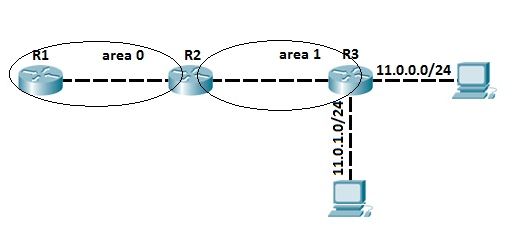Route summarization helps reduce OSPF traffic and route computation. OSPF, unlike EIGRP, doesn’t support automatic summarization. Also, unlike EIGRP, where you can summarize routes on every router in an EIGRP network, OSFP can summarize routes only on ABRs and ASBRs.
The following command is used for OSPF summarization:
(config-router) area AREA_ID range IP_ADDRESS MASK
To better understand OSPF summarization, consider the following example network:
All three routers are running OSPF and exchanging routes. Before OSPF summarization is configured, the router R1 inside the backbone area has two entries for the networks 11.0.0.0/24 and 11.0.1.0/24 in its routing table.
Router#show ip route
Codes: C - connected, S - static, I - IGRP, R - RIP, M - mobile, B - BGP
D - EIGRP, EX - EIGRP external, O - OSPF, IA - OSPF inter area
N1 - OSPF NSSA external type 1, N2 - OSPF NSSA external type 2
E1 - OSPF external type 1, E2 - OSPF external type 2, E - EGP
i - IS-IS, L1 - IS-IS level-1, L2 - IS-IS level-2, ia - IS-IS inter area
* - candidate default, U - per-user static route, o - ODR
P - periodic downloaded static route
Gateway of last resort is not set
10.0.0.0/24 is subnetted, 1 subnets
C 10.0.0.0 is directly connected, FastEthernet0/0
11.0.0.0/24 is subnetted, 2 subnets
O IA 11.0.0.0 [110/3] via 10.0.0.2, 00:00:40, FastEthernet0/0
O IA 11.0.1.0 [110/3] via 10.0.0.2, 00:00:40, FastEthernet0/0
O IA 172.16.0.0/16 [110/2] via 10.0.0.2, 00:00:40, FastEthernet0/0
We could summarize these two subnets on R2, so that R1 receives only one routing update for both subnets. To do that, the following command can be used on R2:
Router(config)#router ospf 1 Router(config-router)#area 1 range 11.0.0.0 255.255.0.0
Now, R1 has only one entry in its routing table for R3’s directly connected subnets:
Router#show ip route
Codes: C - connected, S - static, I - IGRP, R - RIP, M - mobile, B - BGP
D - EIGRP, EX - EIGRP external, O - OSPF, IA - OSPF inter area
N1 - OSPF NSSA external type 1, N2 - OSPF NSSA external type 2
E1 - OSPF external type 1, E2 - OSPF external type 2, E - EGP
i - IS-IS, L1 - IS-IS level-1, L2 - IS-IS level-2, ia - IS-IS inter area
* - candidate default, U - per-user static route, o - ODR
P - periodic downloaded static route
Gateway of last resort is not set
10.0.0.0/24 is subnetted, 1 subnets
C 10.0.0.0 is directly connected, FastEthernet0/0
11.0.0.0/16 is subnetted, 1 subnets
O IA 11.0.0.0 [110/3] via 10.0.0.2, 00:00:30, FastEthernet0/0
O IA 172.16.0.0/16 [110/2] via 10.0.0.2, 00:02:52, FastEthernet0/0
Be careful with summarization. In this case, router R1 thinks that R2 has routes for all subnets in the range 11.0.0.0 – 11.0.255.255. When summarizing, try to be as specific as possible.
Download our Free CCNA Study Guide PDF for complete notes on all the CCNA 200-301 exam topics in one book.
We recommend the Cisco CCNA Gold Bootcamp as your main CCNA training course. It’s the highest rated Cisco course online with an average rating of 4.8 from over 30,000 public reviews and is the gold standard in CCNA training:

